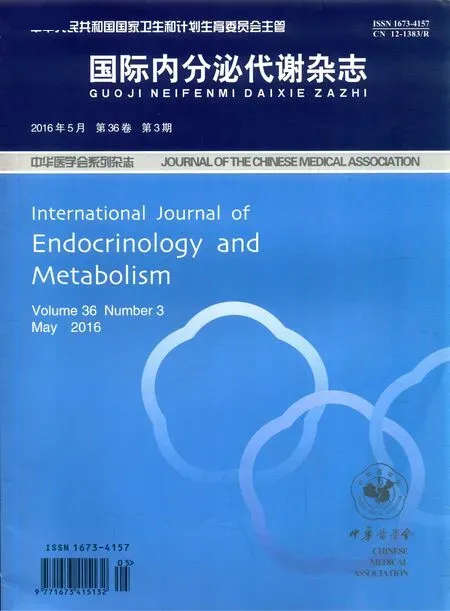血尿酸与糖尿病肾病
周宇 柯甦捷 刘礼斌
·综述·
血尿酸与糖尿病肾病
周宇 柯甦捷 刘礼斌
血尿酸是嘌呤代谢的最终产物。近年来许多大型观察性队列研究已证实,血尿酸与糖尿病肾病的发生、发展密切相关。其主要机制包括内皮功能紊乱,肾素-血管紧张素-醛固酮系统过度激活及炎性瀑布反应等。别嘌呤醇、非布司他及某些调脂、降血压药物等干预糖尿病肾病高尿酸的药物,可以作为传统糖尿病肾病治疗的一种补充。
尿酸;糖尿病肾病;高尿酸血症
在过去的20年间,传统的治疗手段,如严格的血糖、血压控制及对肾素-血管紧张素-醛固酮系统(RAAS)的抑制等,虽能有效延缓糖尿病肾病的进展,但由糖尿病肾病引起的终末期肾病的总患病率并未减少,其仍是糖尿病患者死亡的主要原因之一[1-2]。近年来许多大型观察性队列研究已证实,血尿酸与糖尿病肾病的发生、发展关系密切。降低血尿酸水平是否能成为延缓糖尿病肾病进展的新干预手段?本文将从流行病学研究、相关机制及药物干预治疗等3个方面,简要综述血尿酸与糖尿病肾病的相互关系。
1 尿酸代谢
血尿酸是嘌呤代谢的最终产物。人体内的嘌呤来源分为内源性及外源性两种,内源性嘌呤来源于体内合成及核酸裂解,外源性嘌呤来源于日常饮食摄入。尿酸大部分在肝脏产生,少部分可在肾脏及胃肠道等外周组织产生。由肝脏产生的尿酸以可溶的形式进入血液循环后在肾小球被滤过。肾近端小管重吸收大部分尿酸,最终随尿液排出的尿酸只占总量的10%。
如果体内尿酸产生过多或者排泄减少,血液尿酸浓度大于 6.8 mg/dl(1 mg/dl≈60 μmol/L)时,则出现高尿酸血症。持续的高尿酸血症将使尿酸沉积在关节或软组织中,导致慢性炎性反应,引发痛风。
2 尿酸与糖尿病肾病相关流行病学研究
2009—2010年,来自PERL(Preventing Early Renal Function Loss in Diabetes) 协会的3个流行病学调查研究已发现,血尿酸水平可作为 1型糖尿病患者发展为糖尿病肾病的独立危险因素。其中,Hovind等[3]对263例1型糖尿病患者平均随访18.1年,发现尿酸与持续大量白蛋白尿密切相关,但与微量白蛋白尿无明显关系。校正年龄、性别后发现,血尿酸水平每升高 100 μmol/L,患者发生大量白蛋白尿的风险增加 1.37倍。Jalal等[4]发现,高尿酸水平可以预测1型糖尿病患者蛋白尿的发展,且基线尿酸水平每升高1 mg/dl,微量或大量白蛋白尿的发生风险将提高80%。随后Ficociello等[5]证实,1型糖尿病患者基线的尿酸水平每升高1 mg/dl,早期肾小球滤过率(GFR)下降的风险将增加0.5倍,值得注意的是尿酸水平高于4.5 mg/dl与低于此值相比,早期GFR下降的风险将增加2.4倍,且这些数据在调整尿白蛋白排泄率、年龄、HbA1c及基线的GFR后并没有明显改变。最近Krolewski等[6]将534例1型糖尿病患者分为微量蛋白尿组(n=286,白蛋白排泄率30~299 mg/min)及正常蛋白尿组(n=248,白蛋白排泄率<30 mg/min),平均随访8年,最后发现在这两组中高尿酸水平均与肾功能下降密切相关,基线尿酸水平可以作为肾功能下降的决定性因素之一。此外,这项研究还注意到1型糖尿病患者在微量或正常蛋白尿时期肾功能就已经开始下降了。
2型糖尿病在发病机制上与1型并不相同,但之前的相关研究证实了高尿酸血症可作为2型糖尿病患者发生慢性肾脏疾病(CKD)的独立预测因子[7-8]。最近Kim等[9]对尿酸在2型糖尿病发生、发展中的作用作了更进一步研究。这项回顾性的队列研究共纳入512例2型糖尿病患者,其尿酸处在正常水平,且估算的GFR(eGFR) ≥ 60 ml/(min·1.73 m2)。进一步对所有患者的尿酸水平进行四分位划分(Q4>Q3>Q2>Q1)。在3年的随访中,64例(12%)患者出现了观察终点,即CKD≥3 期[eGFR<60 ml/(min·1.73 m2)]。最高四分位尿酸水平患者比其他3个较低四分位有更高进展到CKD≥3期的风险(vs. Q3,P=0.037;vs. Q2,P<0.001;vs. Q1,P<0.001)。这表明在有一定肾功能[eGFR ≥ 60 ml/(min·1.73 m2)]的2型糖尿病患者中,正常范围内尿酸高值水平对CKD≥3期的发生有预测价值。相似地,Tanaka等[10]在对290例2型糖尿病患者进行平均4.8年的队列研究发现,在肾脏病变开始时正常范围内较高的尿酸水平(男>6.3 mg/dl, 女>5.1 mg/dl)将导致肾功能下降的风险增加。
3 血尿酸致糖尿病肾病潜在的相关作用机制
过去认为持续的高尿酸血症可以使尿酸盐结晶沉积在肾间质,从而产生尿酸性肾病。然而尿酸对肾脏损害的方式并不仅仅局限于此,相关研究表明,尿酸还可能通过多途径导致肾病的发生、发展,包括内皮功能紊乱、RAAS的过度激活、炎性瀑布反应等。
3.1 内皮功能紊乱 内皮功能正常的动脉在血流增加时因一氧化氮的释放而扩张,而内皮功能紊乱的动脉在血流增加时这种反应下降或消失。有体外实验表明,尿酸不仅可以减少内皮细胞产生一氧化氮,而且还可以与其直接反应,增加其消耗。与体外细胞实验相似,在高尿酸的小鼠模型中也证明了高尿酸血症可以通过减少一氧化氮产生,导致内皮功能紊乱。Samant和Chavan[11]发现,伴有高尿酸血症的2型糖尿病患者内皮血流介导的血管舒张功能明显减弱,且与血浆一氧化氮浓度密切相关。Oberbach等[12]利用蛋白质组学的方法发现,不同浓度尿酸能激活多种内皮功能相关转导通路蛋白,例如泛素蛋白酶体通路、eIF4信号通路等,从而导致内皮细胞功能紊乱。Hong等[13]发现,高尿酸血症可以通过Na+/Ca2+交换体介导的线粒体钙超载,诱导内皮功能紊乱。Choi等[14]证实,生理浓度下的尿酸可以通过抑制胰岛素诱导的磷脂酰肌醇3激酶/蛋白激酶B/内皮型一氧化氮合酶信号转导通路,产生内皮功能紊乱,这更是第一次把血管胰岛素抵抗与尿酸诱导的内皮功能紊乱联系在一起。
3.2 RAAS的过度激活 高尿酸血症可以增加肾素的表达,继而通过血管紧张素Ⅱ改变肾小球内血流动力学,诱导系统高血压和肾小球内高压以及肾小管间质损伤,最终导致肾小球硬化和间质纤维化[15-16]。最近Zhang等[17]发现在3T3-L1脂肪细胞中,尿酸可以上调肾素-血管紧张素系统mRNA表达,促进血管紧张素Ⅱ蛋白质的分泌,导致细胞内活性氧簇明显增加,在细胞水平上证实了高尿酸血症与RAAS的活化密切相关。
3.3 炎性瀑布反应 尿酸还可以激活细胞因子肿瘤坏死因子-α、转化生长因子β1和单核细胞趋化因子-1等,产生炎性瀑布反应,进而致肾脏损伤[18-19]。在啮齿类动物高尿酸肾损伤模型中,尿酸诱导的炎性反应是主要的致病机制,而核因子-κB信号转导通路在其中起着至关重要作用[20-21]。Lanaspa等[22]研究发现,果糖激酶可以作为糖尿病肾病发生、发展一种新的介导因子,而尿酸可以激活果糖激酶信号通路。
此外尿酸水平还与所知的肾病进展的其他危险因素密切相关,包括高血压、心血管疾病及动脉粥样硬化等[23-24]。
4 糖尿病肾病患者高尿酸血症的药物干预治疗
有指南指出,痛风最佳治疗方案应包括非药物治疗和药物治疗2方面[25]。无症状高尿酸血症应以非药物治疗为主,一般不推荐使用降尿酸药物。但在经过饮食控制后血尿酸仍高于9 mg/dl及有家族史或伴发相关疾病的血尿酸高于8 mg/dl的患者,可进行降尿酸治疗。
别嘌呤醇作为经典的抗痛风药,已经被证明了能有效降低尿酸水平,且它具有安全,上市早,相对便宜等优点。有临床试验表明,使用别嘌呤醇治疗能降低肾功能下降的风险。该试验招募了51名志愿者(糖尿病患者占25%),他们具有蛋白尿或者血肌酐1.35~4.50 mg/dl,血尿酸>7.6 mg/dl,接受别嘌呤醇治疗1年(100~300 mg/d),最后别嘌呤醇组16%(4/25)的患者出现了肾功能恶化(血肌酐增加>40%),而对照组则是46%(12/26)[26]。Momeni等[27]对40例2型糖尿病患者(尿蛋白>500 mg/24 h且血肌酐<3 mg/dl)进行了一项双盲、随机、安慰剂对照试验,两组都使用了相同剂量的血管紧张素转换酶抑制剂及血管紧张素受体拮抗剂类降压药,与对照组相比,治疗组在接受别嘌呤醇(100 mg/d)治疗4个月后,血尿酸水平及24 h尿白蛋白都有明显下降,说明糖尿病肾病治疗中使用别嘌呤醇是安全、有效的,是对传统糖尿病肾病治疗的一种补充。
非布司他与别嘌呤醇同属黄嘌呤氧化酶抑制剂,有相同的神经激素及抗炎作用,但其降尿酸能力优于别嘌呤醇,且严重皮疹等不良反应少。虽然非布司他在普通人群中有着更安全强大的降尿酸能力,但对于心血管疾病、糖尿病等特殊人群的疗效,需要更多的临床数据评估[28-29]。
高尿酸与代谢综合征密切相关,在一些临床试验中发现,某些调脂药及降血压药虽不能直接对尿酸代谢起作用,但在糖尿病人群中却能达到降尿酸的目的,并且还能降低心血管疾病风险。例如,阿托伐他汀可以在伴有或不伴有心血管疾病的糖尿病人群中明显降低尿酸水平;非诺贝特可以通过提高肾脏排泄率从而达到降尿酸目的;氯沙坦也被证明了对降尿酸有积极的作用。这些药物降尿酸作用可能与改善肾微血管病变,提高GFR等有关。这些发现为糖尿病治疗中降尿酸提供了新的观点,提示上述药物联合别嘌呤醇可能为糖尿病等特殊人群中提供有效的降尿酸的新治疗方案。
综上所述,糖尿病肾病是一种复杂的疾病,血尿酸与其发生、进展有直接关系,降尿酸治疗在糖尿病肾病的防治中有重要意义。在未来,需要更大样本量,设计更合理的临床试验来评估其安全性及有效性。
[1] Marshall SM. Diabetic nephropathy in type 1 diabetes: has the outlook improved since the 1980s[J]Diabetologia,2012,55(9):2301-2306. DOI: 10.1007/s00125-012-2606-1.
[2] Krolewski AS, Bonventre JV. High risk of ESRD in type 1 diabetes: new strategies are needed to retard progressive renal function decline[J].Semin Nephrol,2012,32(5):407-414. DOI: 10.1016/j.semnephrol.2012.07.002.
[3] Hovind P, Rossing P, Tarnow L,et al. Serum uric acid as a predictor for development of diabetic nephropathy in type 1 diabetes: an inception cohort study[J].Diabetes,2009,58(7):1668-1671. DOI: 10.2337/db09-0014.
[4] Jalal DI, Rivard CJ, Johnson RJ,et al. Serum uric acid levels predict the development of albuminuria over 6 years in patients with type 1 diabetes: findings from the Coronary Artery Calcification in Type 1 Diabetes study[J].Nephrol Dial Transplant,2010,25(6):1865-1869.DOI: 10.1093/ndt/gfp740.
[5] Ficociello LH, Rosolowsky ET, Niewczas MA,et al. High-normal serum uric acid increases risk of early progressive renal function loss in type 1 diabetes: results of a 6-year follow-up[J].Diabetes Care,2010,33(6):1337-1343. DOI: 10.2337/dc10-0227.
[6] Krolewski AS, Niewczas MA, Skupien J,et al. Early progressive renal decline precedes the onset of microalbuminuria and its progression to macroalbuminuria[J].Diabetes Care,2014,37(1):226-234.DOI: 10.2337/dc13-0985.
[7] Miao Y, Ottenbros SA, Laverman GD,et al. Effect of a reduction in uric acid on renal outcomes during losartan treatment: a post hoc analysis of the reduction of endpoints in non-insulin-dependent diabetes mellitus with the Angiotensin Ⅱ Antagonist Losartan Trial[J].Hypertension,2011,58(1):2-7.DOI: 10.1161/HYPERTENSIONAHA.111.171488.
[8] Zoppini G, Targher G, Chonchol M,et al. Serum uric acid levels and incident chronic kidney disease in patients with type 2 diabetes and preserved kidney function[J].Diabetes Care,2012,35(1):99-104. DOI: 10.2337/dc11-1346.
[9] Kim WJ, Kim SS, Bae MJ,et al. High-normal serum uric acid predicts the development of chronic kidney disease in patients with type 2 diabetes mellitus and preserved kidney function[J].J Diabetes Complications,2014,28(2):130-134. DOI: 10.1016/j.jdiacomp.2013.11.006.
[10] Tanaka K, Hara S, Hattori M,et al. Role of elevated serum uric acid levels at the onset of overt nephropathy in the risk for renal function decline in patients with type 2 diabetes[J].J Diabetes Investig,2015,6(1):98-104. DOI: 10.1111/jdi.12243.
[11] Samant P, Chavan P. Brachial artery flow mediated vasodilatation changes in endothelium due to hyperuricemia in type 2 diabetes mellitus [J]. Br Med Med Res, 2014, 4(1): 441-450.
[12] Oberbach A, Neuhaus J, Jehmlich N,et al. A global proteome approach in uric acid stimulated human aortic endothelial cells revealed regulation of multiple major cellular pathways[J].Int J Cardiol,2014,176(3):746-752. DOI: 10.1016/j.ijcard.2014.07.102.
[13] Hong Q, Qi K, Feng Z,et al. Hyperuricemia induces endothelial dysfunction via mitochondrial Na+/Ca2+exchanger-mediated mitochondrial calcium overload[J].Cell Calcium,2012,51(5):402-410. DOI: 10.1016/j.ceca.2012.01.003.
[14] Choi YJ, Yoon Y, Lee KY,et al. Uric acid induces endothelial dysfunction by vascular insulin resistance associated with theimpairment of nitric oxide synthesis[J].FASEB J,2014,28(7):3197-3204. DOI: 10.1096/fj.13-247148.
[15] Feig DI, Madero M, Jalal DI,et al. Uric acid and the origins of hypertension[J].J Pediatr,2013,162(5):896-902. DOI: 10.1016/j.jpeds.2012.12.078.
[16] Johnson RJ, Lanaspa MA, Gabriela Sánchez-Lozada L,et al. The discovery of hypertension: evolving views on the role of the kidneys, and current hot topics[J].Am J Physiol Renal Physiol,2015,308(3):F167-F178. DOI: 10.1152/ajprenal.00503.2014.
[17] Zhang JX, Zhang YP, Wu QN,et al. Uric acid induces oxidative stress via an activation of the renin-angiotensin system in 3T3-L1 adipocytes[J].Endocrine,2015,48(1):135-142. DOI: 10.1007/s12020-014-0239-5.
[18] Kushiyama A, Okubo H, Sakoda H,et al. Xanthine oxidoreductase is involved in macrophage foam cell formation and atherosclerosis development[J].Arterioscler Thromb Vasc Biol,2012,32(2):291-298. DOI: 10.1161/ATVBAHA.111.234559.
[19] Nomura J, Busso N, Ives A,et al. Febuxostat, an inhibitor of xanthine oxidase, suppresses lipopolysaccharide-induced MCP-1 production via MAPK phosphatase-1-mediated inactivation of JNK[J].PLoS One,2013,8(9):e75527. DOI: 10.1371/journal.pone.0075527. eCollection 2013.
[20] Fan CY, Wang MX, Ge CX,et al. Betaine supplementation protects against high-fructose-induced renal injury in rats[J].J Nutr Biochem,2014,25(3):353-362. DOI: 10.1016/j.jnutbio.2013.11.010.
[21] Wang MX, Liu YL, Yang Y,et al. Nuciferine restores potassium oxonate-induced hyperuricemia and kidney inflammation in mice[J].Eur J Pharmacol,2015,747:59-70. DOI: 10.1016/j.ejphar.2014.11.035.
[22] Lanaspa MA, Ishimoto T, Cicerchi C,et al. Endogenous fructose production and fructokinase activation mediate renal injury in diabetic nephropathy[J].J Am Soc Nephrol,2014,25(11):2526-2538. DOI: 10.1681/ASN.2013080901.
[23] Zhang J, Xiang G, Xiang L,et al. Serum uric acid is associated with arterial stiffness in men with newly diagnosed type 2 diabetes mellitus[J].J Endocrinol Invest, 2014,37(5):441-447.DOI: 10.1007/s40618-013-0034-9.
[24] Sheikhbahaei S, Fotouhi A, Hafezi-Nejad N,et al. Serum uric acid, the metabolic syndrome, and the risk of chronic kidney disease in patients with type 2 diabetes[J].Metab Syndr Relat Disord,2014,12(2):102-109. DOI: 10.1089/met.2013.0119.
[25] 中华医学会风湿病学分会. 原发性痛风诊断和治疗指南 [J]. 中华风湿病学杂志, 2011, 15(6): 410-413.DOI:10.3760/cma.j.issn.1007-7480.2011.06.013.
[26] Siu YP, Leung KT, Tong MK,et al. Use of allopurinol in slowing the progression of renal disease through its ability to lower serum uric acid level[J].Am J Kidney Dis,2006,47(1):51-59.
[27] Momeni A, Shahidi S, Seirafian S,et al. Effect of allopurinol in decreasing proteinuria in type 2 diabetic patients[J].Iran J Kidney Dis,2010,4(2):128-132.
[28] Shibagaki Y, Ohno I, Hosoya T, et al. Safety, efficacy and renal effect of febuxostat in patients with moderate-to-severe kidney dysfunction[J].Hypertens Res,2014,37(10):919-925. DOI: 10.1038/hr.2014.107.
[29] Tsuruta Y, Mochizuki T, Moriyama T,et al. Switching from allopurinol to febuxostat for the treatment of hyperuricemia and renal function in patients with chronic kidney disease[J].Clin Rheumatol,2014,33(11):1643-1648. DOI: 10.1007/s10067-014-2745-5.
Serumuricacidanddiabeticnephropathy
ZhouYu,KeSujie,LiuLibin.
DepartmentofEndocrinology,UnionHospitalofFujianMedicalUniversity,Fuzhou350001,China
LiuLibin,Email:Libin.Liu@hotmail.com
Serum uric acid is an end product from purine derivatives. Large observational cohort studies in recent years have demonstrated serum uric acid was correlated with the occurrence and development of diabetic nephropathy. The main mechanism mainly includes endothelial dysfunction, increased activity of renin-angiotensin-aldosterone system (RAAS) and induction of inflammatory cascades. Interventions of diabetic nephropathy along with high uric acid, such as allopurinol, febuxostat and some lipid-lowering and antihypentensive drugs, can complement traditional treatment of diabetic nephropathy.
Uric acid; Diabetic nephropathy; Hyperuricemia
10.3760/cma.j.issn.1673-4157.2016.03.15
350001 福州,福建医科大学附属协和医院内分泌科
刘礼斌,Email:Libin.Liu@hotmail.com
2015-06-20)

